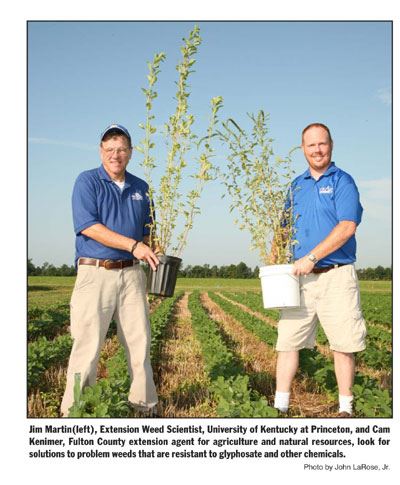Resistance Management
Weeds Are On Counter Attack, Even Against Early Proven Modes Of Action
PRINCETON, KY.
Controlling Palmer Amaranth and waterhemp was a topic discussed by Dr. Jim Martin, extension weed scientist with the University of Kentucky.
“To be honest about it, these are not really new weed species, we’ve had them in Kentucky for several years they just haven’t gotten on the radar screen to the level they are right now,” he said. “Our forecast is they are going to become significantly worse in the not too distant future. At least this is based upon what we’re seeing in the surrounding states especially to the north of us and the south of us.
“The one pigweed I am especially concerned with is Palmer amaranth. Some people call it Palmer pigweed,” Martin continued. “Palmer amaranth is a problem to farmers that are raising cotton and soybeans in the Delta area and other portions of the Southeast. Unfortunately glyphosate resistant Palmer amaranth is starting to show up in Kentucky much like it is showing up in Arkansas, Tennessee, and other parts of the South.”

Some of the initial infestations of Palmer surfaced in the far western part of the state along the Mississippi River bottoms, yet it has now spread to other areas of western Kentucky.
The other weed creating problems is waterhemp.
“We believe some of the waterhemp is coming in from such states as Illinois and Missouri. Some of the first problems with waterhemp in Kentucky have occurred in counties along the Ohio and Green Rivers. However, like Palmer amaranth, waterhemp can be found in other areas of western Kentucky.
Some fields have developed heavy populations of Palmer amaranth. In Fulton County it has gone from just a few scattered fields to a significant part of the river bottoms.
“What’s even more of a concern is now it is starting to show up in the upland fields,” he said. “Combines have probably been our worst enemy for scattering this weed. Combining is an excellent way of getting this stuff from one field to the other and scattering it throughout the field. The early signs of it usually appear along the perimeter or drainage ditches of fields. From there the combines just take that seed on out to other spots.”
Glyphosate is not working on either of these pigweeds and unfortunately some populations appear to be resistant to some other chemistries.
“That’s not good because that just limits our options for managing these weeds,” Martin explained. “The PPO inhibitors play a major role in managing both pigweeds. Examples of these products are Valor, the Authority products, Sharpen, or Flexstar. Those herbicides have done a good job in managing some of these problem weeds, but a concern I have is that some resistance to that chemistry will eventually develop, especially in waterhemp.
“So, again look for some other chemistries out there, things like Dual or metribuzin for preemergence control,” he suggested. “It’s going to take a program approach. Use multiple herbicide chemistries and focus on soil-residual herbicides. If we rely strictly on post emergence herbicides, we’re going to be out there spraying an awful lot. Preemergence herbicides also buy us some time in the early part of the season.
“Anything we’re using, whether it’s Flexstar or Ignite in LibertyLink soybeans, it’s three inches tall, that’s it,” Martin pointed out. “That’s a small weed compared to what most guys are seeing. They say they’re spraying weeds 8 to 10 inches tall and they think that’s small. School’s out when these weeds, especially Palmer amaranth, get that big.”
Martin feels that managing glyphosate resistant Palmer amaranth and waterhemp is going to be a learning experience for some growers. It’s going to require more management and monitoring of problem fields.
“As Larry Steckel from University of Tennessee has said, ‘getting boots on the ground’ is the best way of managing it, and that’s probably a good way of explaining it. We need to have boots on the ground, watching those fields closely, especially for Palmer.”
Sometimes these weeds are not easy to identify, due to the variability in populations; especially with waterhemp. As a general rule, Palmer amaranth and waterhemp do not have any hairs on the stems or leaves.
“Smooth pigweed has been the dominant pigweed in Kentucky for years; it has minute hairs on the stems. So if it has hairs on it, great; if it doesn’t, then it’s time to be taking this thing real serious and get real familiar with what it takes to control those weeds.”
Martin has been working with Cam Kenimer, county extension agent in Fulton County. Kenimer has worked with some of his growers in that county, trying to find ways to manage resistant weeds. He also worked with Drs. Mike Barrett and Bill Witt, University of Kentucky Weed Scientists, on some plot work last year to study problems they’ve experienced in some of the bottoms.
“We weren’t able to get out there early this spring but we’re hopeful that we can get out there later to do some work on some experimental products that we feel will give us an edge on managing some of these problem pigweeds,” Martin said. “So we may be out there doing some additional work this year but Kenimer has taken the lead on that in his county and has worked a lot with us, I know he has worked with UT as well and is trying to get answers for those farmers because they are in desperate need of help in managing this weed.” Δ
BETTY VALLE GEGG-NAEGER: Senior Staff Writer, MidAmerica Farmer Grower